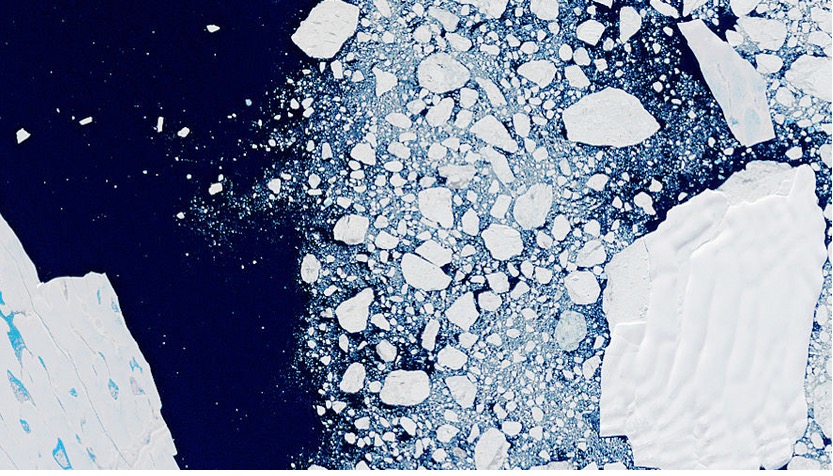Comments
CLIMATE WATCH - "Ice sheets are retreating fast today," said one expert. "But we see traces in the seafloor that the retreat could go faster, way faster, and this is a reminder that we have not seen everything yet."
Peer-reviewed research out Wednesday shows that parts of a huge ice sheet covering Eurasia retreated up to 2,000 feet per day at the end of the last ice age—by far the fastest rate measured to date.
The new finding, published in the journal Nature, upends "what scientists previously thought were the upper speed limits for ice sheet retreat," The Washington Postreported, and it has sparked fears about "how quickly ice in Greenland and Antarctica could melt and raise global sea levels in today's warming world."
As the Post explained:
Scientists monitor ice sheet retreat rates to better estimate contributions to global sea-level rise. Antarctica and Greenland have lost more than 6.4 trillion tons of ice since the 1990s, boosting global sea levels by at least 0.7 inches (17.8 millimeters). Together, the two ice sheets are responsible for more than one-third of total sea-level rise.
The rapid retreat found on the Eurasian ice sheet far outpaces the fastest-moving glaciers studied in Antarctica, which have been measured to retreat as quickly as 160 feet per day. Once the ice retreats toward the land, it lifts from its grounding on the seafloor and begins to float, allowing it to flow faster and increase the contribution to sea-level rise.
If air and ocean temperatures around Antarctica were to increase as projected and match those at the end of the last ice age, researchers say ice marching backward hundreds of feet in a day could trigger a collapse of modern-day glaciers sooner than previously thought. That could be devastating for global sea levels.
"If temperatures continue to rise, then we might have the ice being melted and thinned from above as well as from below," lead author Christine Batchelor, a physical geographer at Newcastle University, told the newspaper. "That could kind of end up with a scenario that looks more similar to what we had [off] Norway after the last glaciation."
Using ship-borne imagery of ridges along the seafloor, Batchelor and her colleagues found that the Norwegian continental ice shelf retreated 180 to 2,000 feet per day, with the fastest retreat rates lasting for a period of days to a few months.
"This is not a model. This is real observation," Eric Rignot, a glaciologist at the University of California at Irvine who was not involved in the new study, told thePost. "And it is frankly scary. Even to me."
Prior to the publication of the new research, one of the fastest glacial retreat rates detected was at Pope Glacier in West Antarctica. This smaller glacier is not far from the massive Thwaites Glacier, which is nicknamed the "doomsday glacier" due to projections about how its melting is poised to contribute significantly to sea-level rise.
Rignot was part of the team that published a paper last year documenting the retreat of Pope Glacier. Based on satellite calculations, the 2022 study found that during a period in 2017, the glacier retreated at a rate of roughly 105 feet per day, or about 20 times slower than the fastest rate detected for the Eurasian ice sheet in the new study.
"Ice sheets are retreating fast today, [especially] in Antarctica," Rignot said Wednesday. "But we see traces in the seafloor that the retreat could go faster, way faster, and this is a reminder that we have not seen everything yet."
Temperature rise, meanwhile, shows no signs of slowing down.
Before last year's COP27 climate summit—which ended, like the 26 meetings before it, with no concrete plan to rapidly move away from planet-heating fossil fuels—the U.N. warned that existing emissions reductions targets and policies are so inadequate that there is "no credible path" currently in place to achieve the Paris agreement's goal of limiting global warming to 1.5°C, beyond which impacts will grow increasingly deadly, particularly for people in low-income countries who have done the least to cause the crisis.
The U.N. made clear that only "urgent system-wide transformation" can prevent catastrophic temperature rise of up to 2.9°C by 2100, but oil and gas corporations—bolstered by trillions of dollars in annual public subsidies—are still planning to expand fossil fuel production in the coming years, prioritizing short-term profits over the lives of those who will be harmed by the resulting climate chaos.
(Kenny Stancil is a staff writer for Common Dreams where this article was first featured.)















